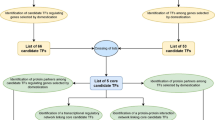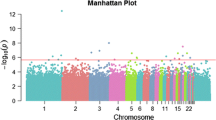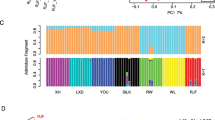Abstract
Animal domestication is a model of a rapid evolutionary process. In experimental fox domestication, the time required for the emergence and fixation of specific evolutionary changes was reduced from thousands to tens of years, compared to historical domestication. Tame foxes were obtained by extreme selective breeding for emotionally positive response toward humans. Unselected foxes, as well as foxes bred for enhanced aggressiveness to humans were used as control. Epigenetic regulation of gene expression is considered as one of the possible mechanisms of rapid evolution. In this study, expression of DNA methyltransferase genes, DNMT1 and DNMT3A, was investigated. It was demonstrated that, in tame foxes, the level of DNMT3A gene expression in the prefrontal cortex, hippocampus, and spleen was increased by more than 2 times in comparison with aggressive and unselected foxes. At the same time, the DNMT1 expression level did not differ among the studied groups of animals. A possible reason for the differences found in the DNMT3A expression could be the changes in the level and metabolism of methionine, which serves as a donor of methyl groups during DNA methylation. However, this study showed that there were no differences in the serum methionine levels between tame, unselected, and aggressive foxes. Thus, the data support the hypothesis that selection for positive emotional response toward humans affected the DNA methylation machinery.
Similar content being viewed by others
References
Belyaev, D.K., Domestication of animals, Sci. J., 1969, vol. 5, pp. 47–52.
Belyaev, D.K., Destabilizing selection as a factor of domestication, in Genetika i blagosostoyanie chelovechestva (Genetics and the Welfare of Humankind), Moscow: Nauka, 1981, pp. 53–66.
Trut, L.N., Plyusnina, I.Z., and Oskina, I.N., An experiment on fox domestication and debatable issues of evolution of the dog, Russ. J. Genet., 2004, vol. 40, no. 6, pp. 644–655.
Trut, L.N., Herbek, Yu.E., Kharlamova, A.V., et al., Fox domestication: molecular mechanisms involved in selection for behavior, Vavilovskii Zh. Genet. Sel., 2013, vol. 17, no. 2, pp. 226–233.
Trut, L., Oskina, I., and Kharlamova, A., Animal evolution during domestication: the domesticated fox as a model, BioEssays, 2009, vol. 31, no. 3, pp. 349–360. doi 10.1002/bies.200800070
Oskina, I.N., Herbek, Yu.E., Shikhevich, S.G., et al., Changing in the hypothalamic-pituitary-adrenal axis and immune systems during the selection of animals for domestication behavior, Inf. Vestn. Vavilovskogo O-va Genet. Sel., 2008, vol. 12, nos. 1–2, pp. 39–49.
Vaido, A.I., Dyuzhikova, N.A., Shiryaeva, N.V., et al., Systemic control of the molecular, cell, and epigenetic mechanisms of long-lasting consequences of stress, Russ. J. Genet., 2009, vol. 45, no. 3, pp. 298–303.
Dulac, C., Brain function and chromatin plasticity, Nature, 2010, vol. 465, pp. 728–735. doi 10.1038/nature09231
Turecki, G. and Meaney, M.J., Effects of the social environment and stress on glucocorticoid receptor gene methylation: a systematic review, Biol. Psychiat., 2016, vol. 79, no. 2, pp. 87–96. doi 10.1016/j.biopsych. 2014.11.022
Weaver, I.C.G., Cervoni, N., Champagne, F.A., et al., Epigenetic programming by maternal behavior, Nat. Neurosci., 2004, vol. 7, no. 8, pp. 847–854. doi 10.1038/nn1276
Zhang, T.Y., Labonté, B., Wen, X.L., et al., Epigenetic mechanisms for the early environmental regulation of hippocampal glucocorticoid receptor gene expression in rodents and humans, Neuropsychopharmacology, 2013, vol. 38, no. 1, pp. 111–123. doi 10.1038/npp.2012. 149
Wang, D., Szyf, M., Benkelfat, C., et al., Peripheral SLC6A4 DNA methylation is associated with in vivo measures of human brain serotonin synthesis and childhood physical aggression, PLoS One, 2012, vol. 7, no. 6. e39501. doi 10.1371/journal.pone.0039501
Miller, C.A. and Sweatt, J.D., Covalent modification of DNA regulates memory formation, Neuron, 2007, vol. 53, no. 6, pp. 857–869. doi 10.1016/j.neuron.2007.02.022
Gräff, J. and Mansuy, I.M., Epigenetic codes in cognition and behaviour, Behav. Brain. Res., 2008, vol. 192, no. 1, pp. 70–87. doi 10.1016/j.bbr.2008.01.021
McGowan, P.O., Sasaki, A., D’Alessio, A.C., et al., Epigenetic regulation of the glucocorticoid receptor in human brain associates with childhood abuse, Nat. Neurosci., 2009, vol. 12, no. 3, pp. 342–348. doi 10.1038/nn.2270
Jakovcevski, M. and Akbarian, S., Epigenetic mechanisms in neurological disease, Nat. Med., 2012, vol. 18, no. 8, pp. 1194–1204. doi 10.1038/nm.2828
Grayson, D.R. and Guidotti, A., The dynamics of DNA methylation in schizophrenia and related psychiatric disorders, Neuropsychopharmacology, 2013, vol. 38, no. 1, pp. 138–166. doi doi 10.1038/npp.2012.125
Zhang, T.Y., Hellstrom, I.C., Bagot, R.C., et al., Maternal care and DNA methylation of a glutamic acid decarboxylase 1 promoter in rat hippocampus, J. Neurosci., 2010, vol. 30, no. 39, pp. 13130–13137. doi 10.1523/JNEUROSCI.1039-10.2010
Nätt, D., Rubin, C.J., Wright, D., et al., Heritable genome-wide variation of gene expression and promoter methylation between wild and domesticated chickens, BMC Genomics, 2012, vol. 13, p. 59. doi 10.1186/1471-2164-13-59
LaPlant, Q., Vialou, V., Iii, H.E.C., et al., Dnmt3a regulates emotional behavior and spine plasticity in the nucleus accumbens, Nat. Neurosci., 2010, vol. 13, no. 9, pp. 1137–1143. doi 10.1038/nn.2619
Anier, K., Malinovskaja, K., Pruus, K., et al., Maternal separation is associated with DNA methylation and behavioural changes in adult rats, Eur. Neuropsychopharmacol., 2014, vol. 24, no. 3, pp. 459–468. doi 10.1016/j.euroneuro.2013.07.012
Jablonka, E. and Raz, G., Transgenerational epigenetic inheritance: prevalence, mechanisms, and implications for the study of heredity and evolution, Q. Rev. Biol., 2009, vol. 84, no. 2, pp. 131–176. doi 10.1086/598822
Danchin, É., Charmantier, A., Champagne, F.A., et al., Beyond DNA: integrating inclusive inheritance into an extended theory of evolution, Nat. Rev. Genet., 2011, vol. 12, no. 7, pp. 475–486. doi 10.1038/nrg3028
Ledón-Rettig, C.C., Richards, C.L., and Martin, L.B., Epigenetics for behavioral ecologists, Behav. Ecol., 2013, vol. 24, no. 2, pp. 311–324. doi 10.1093/beheco/ ars145
Danchin, É. and Pocheville, A., Inheritance is where physiology meets evolution, J. Physiol., 2014, vol. 592, no. 11, pp. 2307–2317. doi 10.1113/jphysiol.2014. 272096
Belyaev, D.K., Destabilizing selection as a factor in variation of animals under domestication, Priroda (Moscow, Russ. Fed.) 1979, no. 2, pp. 36–45.
Gerbek, Yu.E., Os’kina, I.N., Gulevich, R.G., and Plyusnina, I.Z., Effects of maternal methyl-supplement diet on hippocampal glucocorticoid receptor mRNA expression in rats selected for behavior, Cytol. Genet., 2010, vol. 44, no. 2, pp. 108–113. doi 10.3103/S0095452710020064
Belyaev, D.K., Ruvinskii, A.O., and Trut, L.N., The value of the inherited activation and inactivation of genes in animal domestication, Genetica (Moscow), 1979, vol. 15, no. 11, pp. 2033–2055.
Plyusnina, I. and Oskina, I., Behavioral and adrenocortical responses to open-field test in rats selected for reduced aggressiveness toward humans, Physiol. Behav., 1997, vol. 61, no. 3, pp. 381–385. doi 10.1016/ S0031-9384(96)00445-3
Plyusnina, I.Z., Oskina, I.N., Tibeikina, M.A., and Popova, N.K., Cross-fostering effects on weight, exploratory activity, acoustic startle reflex and corticosterone stress response in Norway gray rats selected for elimination and for enhancement of aggressiveness towards human, Behav. Genet., 2009, vol. 39, no. 2, pp. 202–212. doi 10.1007/s10519-008-9248-6
Albert, F.W., Shchepina, O., Winter, C., et al., Phenotypic differences in behavior, physiology and neurochemistry between rats selected for tameness and for defensive aggression towards humans, Horm. Behav., 2008, vol. 53, no. 3, pp. 413–421. doi 10.1016/j.yhbeh.2007.11.010
Tremolizzo, L., Carboni, G., Ruzicka, W.B., et al., An epigenetic mouse model for molecular and behavioral neuropathologies related to schizophrenia vulnerability, Proc. Natl. Acad. Sci. U.S.A., 2002, vol. 99, no. 26, pp. 17095–17100. doi 10.1073/pnas.262658999
Carlin, J., George, R., and Reyes, T.M., Methyl donor supplementation blocks the adverse effects of maternal high fat diet on offspring physiology, PLoS One, 2013, vol. 8, no. 5. e63549. doi 10.1371/journal.pone. 0063549
Giudicelli, F., Brabant, A.-L., Grit, I., et al., Excess of methyl donor in the perinatal period reduces postnatal leptin secretion in rat and interacts with the effect of protein content in diet, PLoS One, 2013, vol. 8, no. 7. e68268. doi 10.1371/journal.pone.0068268
Ishii, D., Matsuzawa, D., Matsuda, S., et al., Methyl donor-deficient diet during development can affect fear and anxiety in adulthood in C57BL/6J mice, PLoS One, 2014, vol. 9, no. 8. e105750. doi 10.1371/journal. pone.0105750
McGowan, P.O., Meaney, M.J., and Szyf, M., Diet and the epigenetic (re)programming of phenotypic differences in behavior, Brain Res., 2008, no. 1237, pp. 12–24. doi 10.1016/j.brainres.2008.07.074
Prasolova, L.A., Os’kina, I.N., Plyusnina, I.Z., and Trut, L.N., Maternal methyl supplements affect the phenotypic variation of the agouti gene in the offspring of rats with different behavioral types, Russ. J. Genet., 2009, vol. 45, no. 5, pp. 587–592.
Huang, S., Slomianka, L., Farmer, A.J., et al., Selection for tameness, a key behavioral trait of domestication, increases adult hippocampal neurogenesis in foxes, Hippocampus, 2015, vol. 25, no. 8, pp. 963–975. doi 10.1002/hipo.22420
Ye, J., Coulouris, G., Zaretskaya, I., et al., Primer-BLAST: a tool to design target-specific primers for polymerase chain reaction, BMC Bioinformatics, 2012, vol. 13, p. 134. doi 10.1186/1471-2105-13-134
Kukekova, A.V., Johnson, J.L., Teiling, C., et al., Sequence comparison of prefrontal cortical brain transcriptome from a tame and an aggressive silver fox (Vulpes vulpes), BMC Genomics, 2011, vol. 12, p. 482. doi 10.1186/1471-2164-12-482
Schwarz, E.L., Roberts, W.L., and Pasquali, M., Analysis of plasma amino acids by HPLC with photodiode array and fluorescence detection, Clin. Chim. Acta, 2005, vol. 354, nos. 1–2, pp. 83–90. doi 10.1016/j.cccn. 2004.11.016
Abbott, N.J., Patabendige, A.A.K., Dolman, D.E.M., et al., Structure and function of the blood–brain barrier, Neurobiol. Dis., 2010, vol. 37, no. 1, pp. 13–25. doi 10.1016/j.nbd.2009.07.030
Guo, J.U., Su, Y., Shin, J.H., et al., Distribution, recognition and regulation of non-CpG methylation in the adult mammalian brain, Nat. Neurosci., 2014, vol. 17, no. 2, pp. 215–222. doi 10.1038/nn.3607
Oliveira, A.M.M., Hemstedt, T.J., and Bading, H., Rescue of aging-associated decline in Dnmt3a2 expression restores cognitive abilities, Nat. Neurosci., 2012, vol. 15, no. 8, pp. 1111–1113. doi 10.1038/nn.3151
Chen, B.-F. and Chan, W.-Y., The de novo DNA methyltransferase DNMT3A in development and cancer, Epigenetics, 2014, vol. 9, no. 5, pp. 669–677. doi 10.4161/epi.28324
Hunter, R.G. and McEwen, B.S., Stress and anxiety across the lifespan: structural plasticity and epigenetic regulation, Epigenomics, 2013, vol. 5, no. 2, pp. 177–194.
Morris, M.J., Adachi, M., Na, E.S., and Monteggia, L.M., Selective role for DNMT3a in learning and memory, Neurobiol. Learn. Mem., 2014, vol. 115, pp. 30–37. doi 10.1016/j.nlm.2014.06.005
Nguyen, S., Meletis, K., Fu, D., et al., Ablation of de novo DNA methyltransferase Dnmt3a in the nervous system leads to neuromuscular defects and shortened lifespan, Dev. Dyn., 2007, vol. 236, no. 6, pp. 1663–1676. doi 10.1002/dvdy.21176
Vanyushin, B.F. and Romanenko, E.B., The change of rat DNA methylation in ontogenesis and under the influence of hydrocortisone, Biokhimiya (Moscow), 1979, vol. 44, no. 1, pp. 78–85.
Elliott, E., Manashirov, S., Zwang, R., et al., Dnmt3a in the medial prefrontal cortex regulates anxiety-like behavior in adult mice, J. Neurosci., 2016, vol. 36, no. 3, pp. 730–740. doi 10.1523/JNEUROSCI.0971- 15.2016
Zhu, Q., Wang, L., Zhang, Y., et al., Increased expression of DNA methyltransferase 1 and 3a in human temporal lobe epilepsy, J. Mol. Neurosci., 2012, vol. 46, no. 2, pp. 420–426. doi 10.1007/s12031-011-9602-7
Kolpakov, V.G., Barykina, N.N., Alekhina, T.A., and Ponomarev, I.Y., Some Genetic Animal Models for Comparative Psychology and Biological Psychiatry, Novosibirsk: Institute of Cytology and Genetics, Siberian Branch of the Russian Academy of Sciences, 1996.
Belyaev, D.K., Genetics, society, personality, in Problemy genetiki i teorii evolyutsii (Challenges in Genetics and Evolutionary Theory), Novosibirsk: Nauka, 1991, pp. 43–51.
Wrangham, R. and Pilbeam, D., African apes as time machines, in All Apes Great and Small, vol. 1: African Apes, New York: Kluwer, 2001, pp. 5–17.
Allis, D., Jenuwein, T., and Reinberg, D., Overview and concepts, in Epigenetics, Allis, D., Jenuwein, T., Reinberg, D., and Caparros, M.L., Eds., Cold Spring Harbor: Cold Spring Harbor Laboratory, 2007.
Di Ruscio, A., Ebralidze, A.K., Benoukraf, T., et al., DNMT1-Interacting RNAs block gene-specific DNA methylation, Nature, 2013, vol. 503, pp. 371–376. doi doi 10.1038/nature12598
Marchal, C. and Miotto, B., Emerging concept in DNA methylation: role of transcription factors in shaping DNA methylation patterns, J. Cell. Physiol., 2015, vol. 230, no. 4, pp. 743–751. doi 10.1002/jcp.24836
Author information
Authors and Affiliations
Corresponding author
Additional information
Original Russian Text © Yu.E. Herbeck, A.R. Khantemirova, E.V. Antonov, N.I. Goncharova, R.G. Gulevich, D.V. Shepeleva, L.N. Trut, 2017, published in Genetika, 2017, Vol. 53, No. 4, pp. 480–487.
Rights and permissions
About this article
Cite this article
Herbeck, Y.E., Khantemirova, A.R., Antonov, E.V. et al. Expression of the DNA methyltransferase genes in silver foxes experimentally selected for domestication. Russ J Genet 53, 483–489 (2017). https://doi.org/10.1134/S1022795417040056
Received:
Revised:
Published:
Issue Date:
DOI: https://doi.org/10.1134/S1022795417040056




